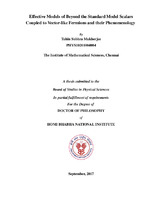- DSpace Home
- →
- IMSc Theses/ Dissertations
- →
- IMSc Theses/ Dissertations
- →
- View Item
JavaScript is disabled for your browser. Some features of this site may not work without it.
| dc.contributor.author | Tuhin Subhra Mukherjee | |
| dc.date.accessioned | 2017-10-11T10:58:17Z | |
| dc.date.available | 2017-10-11T10:58:17Z | |
| dc.date.issued | 2017 | |
| dc.date.submitted | 2017 | |
| dc.identifier.uri | https://dspace.imsc.res.in/xmlui/handle/123456789/410 | |
| dc.description.abstract | Many beyond the standard model (BSM) extensions such as little-Higgs models, certain extra dimensional models, composite Higgs models, contain additional neutral scalars other than the standard model Higgs boson. These models typically also contain new vector-like fermions (VLF) in their framework. In this thesis, we study the phenomenology of BSM neutral scalars coupled to VLFs in a model-independent way. Such a study captures some of the phenomenological features of many BSM theories. We perform a model-independent analysis of a general scalar φ, either CP-even or CP-odd, coupled to the SM fermions and gauge bosons. We focus on this scalar produced via gluon fusion. We obtain the 8 TeV and the 14 TeV LHC gluon fusion cross section σ(gg→φ) in terms of the effective φgg coupling (κφgg). We obtain the constraints on the κφgg and the branching ratios BR(φ→γγ, τ+τ-, tt) from the 8 TeV LHC results. In any given model one can calculate the (κφgg), these BRs and use our results to get the cross sections and the constraints on the model parameters. We consequently study the phenomenology of some effective models of BSM scalars coupled to VLFs. We consider an SM singlet CP-odd scalar A coupled to colored VLFs which are either SU(2)L singlet or SU(2)L doublet. We present the (κAgg) and BR(A→VV) in each of these models, where "V" denotes the SM gauge bosons. We consider several models where VLFs are introduced into the two Higgs doublet model (2HDM) type-II and X. We separately consider two cases, one in which the VLFs mix with the SM third generation quarks and one in which these mixings are absent. We present the κφgg and the branching ratios of the neutral scalars present in the 2HDM, highlighting the effects of the VLFs. For one of the models, we find that the constraints on the 2HDM model parameter space from the 8 TeV LHC φ→τ+τ- channel exclusion limits are looser than that obtained for the 2HDM type-II without VLFs. In the final part of the thesis, we focus on the diphoton rate of the BSM neutral scalars and the possibility of a gauge singlet VLF to be the dark matter. The diphoton study can be useful in the future in discovering such BSM neutral scalars. We present the 13 TeV LHC σ(gg→φ→γγ) in terms of κφgg and κφ γγ for various φ widths and discuss the constraints arising from the 8 TeV LHC (φ→ τ+τ-,tt,hh) results. We analyze the 2HDM-II with SM fermions only and few models where we add VLLs and/or VLQs to 2HDM of type-II, X and I. We analyze a model where a singlet scalar is coupled to an SU(2)L singlet VLQ, an SU(2)L singlet VLL and the SM Higgs. For each of these models, we present the σ(gg→φ→γγ). We also present the constraints on the model parameter space from the 8 TeV LHC results and the perturbative unitarity constraint. We construct a singlet scalar model containing a singlet vector-like lepton (VLL) that can be identified as dark matter if it has zero hypercharge and is absolutely stable. We study the dark matter implications of this model showing the regions of the parameter space which give the correct relic density while also satisfying the dark matter direct detection limits. | en_US |
| dc.publisher.publisher | The Institute of Mathematical Sciences | |
| dc.subject | Phenomenology | en_US |
| dc.subject | Beyond the Standard Model | en_US |
| dc.subject | HBNI Th 123 | en_US |
| dc.title | Effective Models of Beyond the Standard Model Scalars Coupled to Vector-like Fermions and their Phenomenology[HBNI Th123] | en_US |
| dc.type.degree | Ph.D | en_US |
| dc.type.institution | HBNI | en_US |
| dc.description.advisor | Shrihari Gopalakrishna | |
| dc.description.pages | 155p. | en_US |
| dc.type.mainsub | Physics | en_US |
| dc.type.hbnibos | Physical Sciences |
Files in this item
This item appears in the following Collection(s)
-
IMSc Theses/ Dissertations
IMSc Theses/ Dissertations
